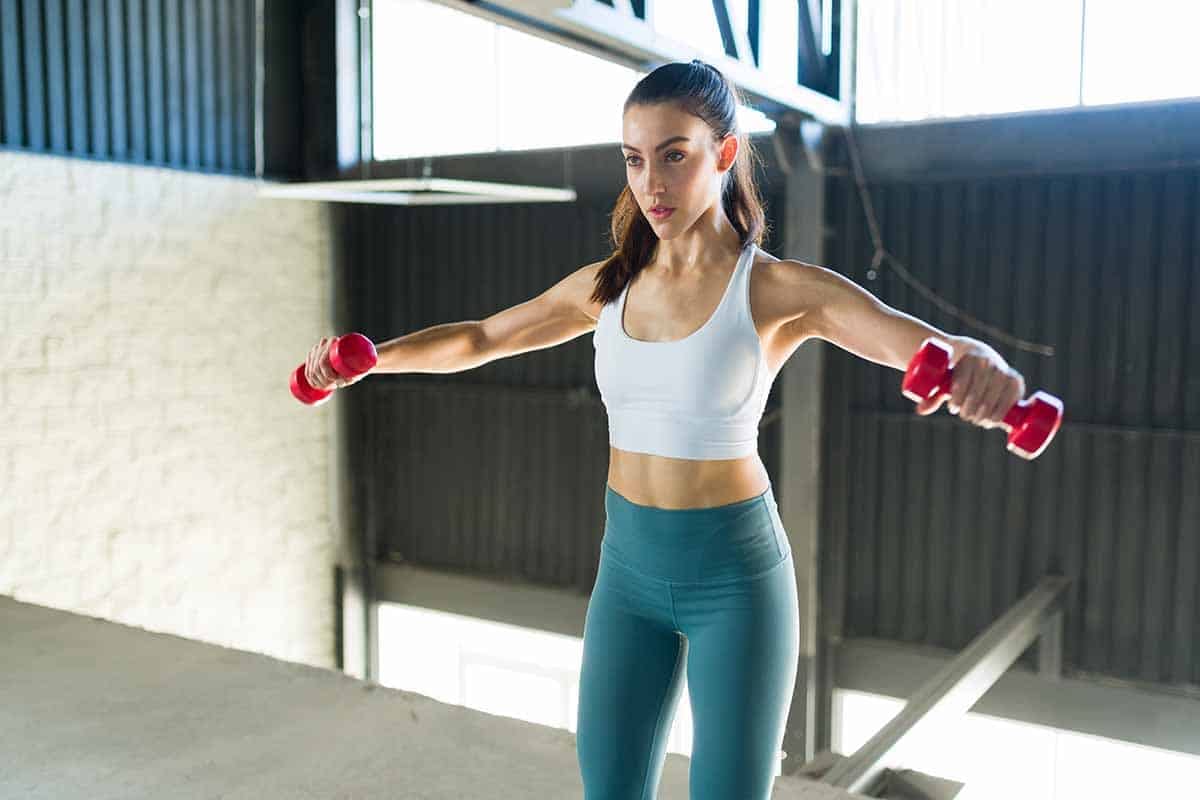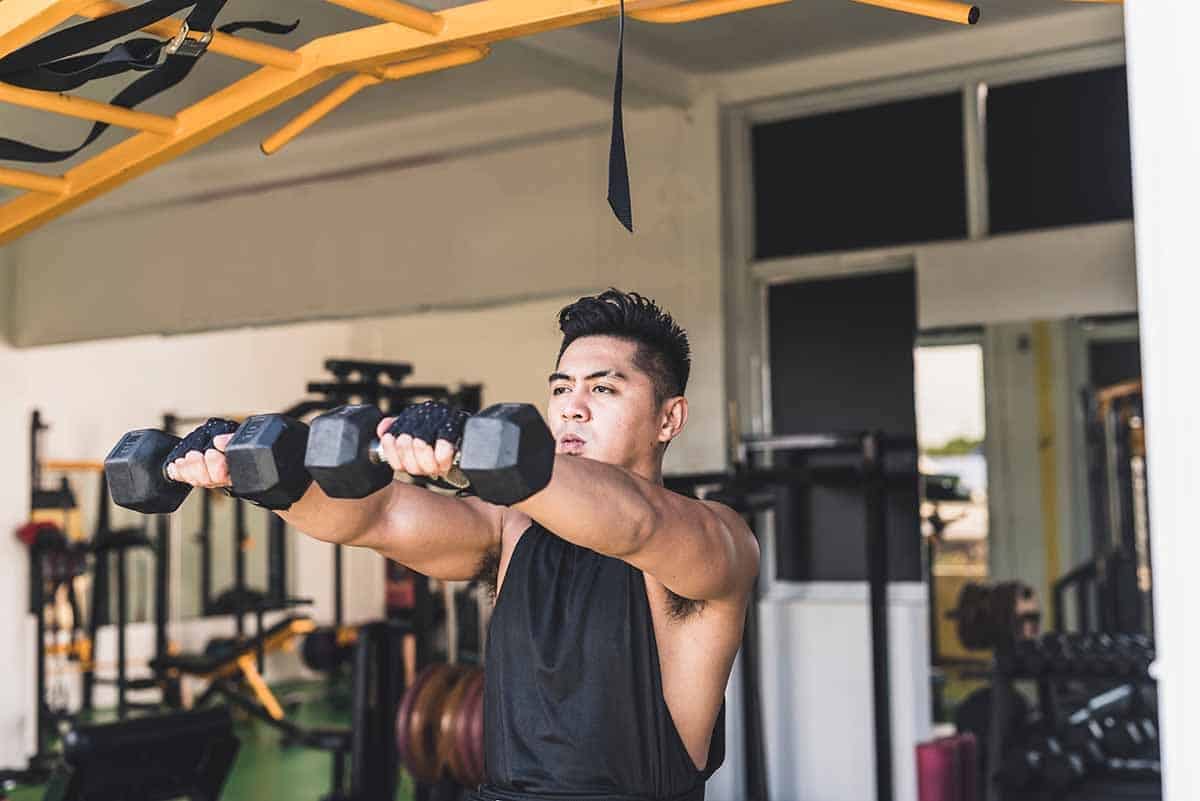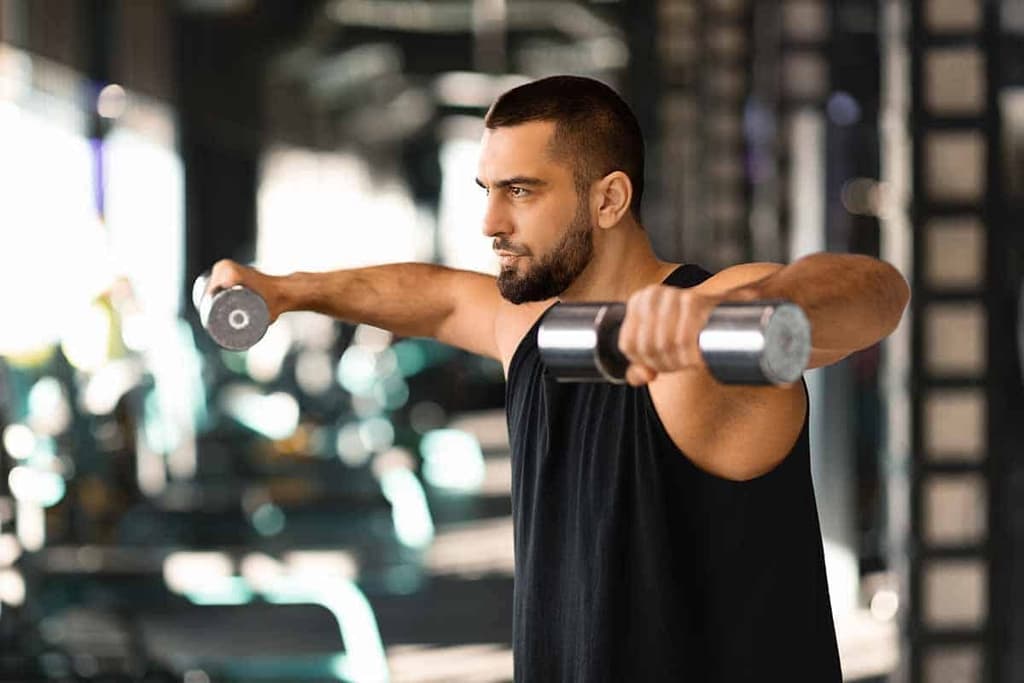Isolate Shoulder Exercises: 5 Moves to Strengthen Your Shoulders
Do you want to exercise your shoulder muscles and make them stronger? These isolate shoulder exercises can help you define your shoulders...
Shoulder isolation exercises are small movements with a big impact. An isolation exercise works across one muscle group or joint to concentrate your movement in one area of the body.
This can help equalize imbalanced muscles and stimulate stubborn muscle growth. If you’re having a tough time growing your shoulder muscles, fear not!
This article will give you a guide to isolate shoulder exercises so you’re working only with one joint. We will help you understand shoulder anatomy and also outline the top 5 shoulder isolation exercises, offer form tips, and show you how to include these moves in your weekly workout routine.
Why Should I Do Shoulder Isolation Exercises?
Great shoulders are not built easily. Just as much as your shoulder joint is mobile (the most mobile in your body), it is easily injured!
These sensitive joints are prone to:
- Shoulder Impingement Syndrome
- Fractures
- Tendonitis
- Rotator cuff injury
- Adhesive capsulitis (also known as “frozen shoulder”)
To understand more about shoulder injuries and what risks your shoulders may be facing, here’s a handy guide: Overview— shoulder pain.
The high potential for injury makes it a good idea to keep your shoulder joints and their surrounding muscles as strong as possible.
Shoulder Joint Anatomy
And now for a simple (as simple as possible for such a complex joint, anyway!) explanation of the shoulder joint:
The shoulder joint, also known as the glenohumeral joint, is where your upper arm bone (the humerus) fits into a shallow socket in your shoulder blade (aka, your scapula). It's located right at the point where your arm connects to your body.
Where is your shoulder joint?
- It is at the top of your arm, where your arm attaches to your torso. If you touch the spot where your arm meets your body, that's your shoulder joint.
What does your shoulder joint do?
- It lets you move your arms in different directions. You can lift your arm up, move it to the side, rotate it, or swing it in circles or across the body. Your glenohumeral joint is the most mobile in your entire body, letting you do everything from throwing a ball to reaching high objects on your pantry shelves.
Surrounding Muscles
Now that we understand the joint itself, there are several key muscles surrounding your shoulder joint that are considered your shoulder muscles.
- Deltoids: Deltoids (aka “delts) are the rounded muscles on the top of your shoulders. When we think about the shape that your shoulders make to create a wider frame, this is primarily attributable to your deltoids. Your delts help you lift your arms and rotate them. This muscle group is divided into three: front delts (see Front Delt Workout for more on this part of the muscle!), side delts and rear delts.
- Rotator Cuff Muscles: This is a group of four small muscles: supraspinatus, infraspinatus, teres minor, and subscapularis. They surround your shoulder joint, helping you keep it stable and letting you lift and rotate your arms.
- Trapezius: This large, triangular muscle extends from your neck, across your shoulders, to the middle of your back. It helps move your shoulder blades and supports arm movements.
- Pectoralis Major: This is the large chest muscle that also plays a role in moving your shoulder joint, especially in actions like pushing.
In short, the shoulder joint is like a ball-and-socket that gives your arm a wide range of motion, making it possible to perform lots of different activities.
Top Isolate Shoulder Exercises
While compound shoulder exercises like overhead presses are crucial for overall shoulder development, isolation shoulder exercises allow for more precise targeting of specific areas that may be lagging or need extra attention.
Here are some of the best isolate shoulder exercises you can try.
1. Lateral Raises

- Set-Up: Grab a pair of dumbbells, one in each hand. Stand with your feet shoulder-width apart.
- Body Position: Keep your arms at your sides, palms facing your body. Keep your elbows slightly bent.
- Action: Slowly lift your dumbbells out to the sides until your arms come parallel to the floor in a T-shape. Keep your palms facing down with your elbows slightly bent.
- Reverse: Lower your dumbbells back down with control.
- Reps: 3 sets of 12-15 reps.
2. Front Raises

- Set-Up: Hold a pair of dumbbells with your palms facing your thighs. Stand with your feet hip-width apart.
- Body Position: Keep your arms straight but not locked out. Stand tall with a slight bend in your knees.
- Action: Raise one or both of your dumbbells in front of you to shoulder height. Keep your palms facing down.
- Reverse: Slowly lower the dumbbells back down.
- Reps: 3 sets of 10-12 reps.
Pro-Tip: For this move, you may want to opt between alternating sides and lifting both hands at the same time. Trying a lift using both arms and raising your weights at the same pace may help you identify a weaker shoulder.
If one of your weights feels more reluctant to come up than the other in a front raise, there’s a good chance you have a shoulder muscle strength imbalance. But don’t worry, with these exercises you can fix this problem.
3. Bent-Over Reverse Flyes
- Set-Up: Grab a pair of dumbbells and stand with your feet hip-width apart. Hinge from your hips. Keep your back straight, your neck long, and your core engaged.
- Body Position: Let your dumbbells hang down in front of your thighs with your palms facing each other. Keep a slight bend in your elbows.
- Action: Lift your dumbbells out to the sides, squeezing your shoulder blades together. Pause at the top.
- Reverse: With control, slowly resist your weight to lower your dumbbells back to the starting position.
- Reps: 3 sets of 12-15 reps.
4. Arnold Press
- Set-Up: Sit on a weight bench, preferably one with back support. Hold a light to medium-weight dumbbell in each hand. Start with your palms facing your body at shoulder height.
- Body Position: Plant your feet flat on the floor, engaging your core and sitting up straight.
- Action: Rotate your palms to face forward as you press your dumbbells overhead at the same time. Fully extend your arms at the top without locking out your elbows.
- Reverse: Lower your dumbbells back to the starting position, flipping your palms back the way they came to face your body on the way down.
- Reps: 3 sets of 10-12 reps.
What are the key differences between an Arnold Press and a standard shoulder press? Here’s a quick guide to help you unpack these two similar moves and see which you should pick for your shoulder routine: Arnold Press vs. Shoulder Press.
5. Cable Lateral Raises
- Set-Up: Stand next to a cable machine. Attach your handle to the lowest pulley. Cross one arm over your body to hold your handle with the hand furthest from your machine.
- Body Position: Keep a slight bend in your elbow, stand upright and keep your core tight. You can keep your feet shoulder-width apart, but some people prefer their feet in a narrow or split stance (one staggered in front of the other).
- Action: Lift your arm out to the side until it’s parallel to the floor. Keep your palm facing down.
- Reverse: Resist the pull of your cable to slowly return to the starting position with control.
- Reps: 3 sets of 12-15 reps.
Weekly Workout Plan
Here’s a weekly total body workout plan focused on shoulder isolation exercises while also seeing to other major muscle groups.
This plan can help you balance muscle groups so you get a comprehensive workout routine.
Day 1: Upper Body Focus
Warm-Up
- 5-10 minutes of light cardio and dynamic stretches
Workout
- Lateral Raises: 3 sets of 12-15 reps
- Bench Press: 3 sets of 8-12 reps
- Seated Row: 3 sets of 10-12 reps
- Front Raises: 3 sets of 12-15 reps
- Bicep Curls: 3 sets of 10-12 reps
- Tricep Dips: 3 sets of 10-12 reps
Cool Down
- 5-10 minutes of stretching, focusing on your upper body
Day 2: Lower Body Focus
Warm-Up
- 5-10 minutes of light cardio and dynamic stretching
Workout
- Squats: 3 sets of 10-12 reps
- Lunges: 3 sets of 10-12 reps (per leg)
- Leg Press: 3 sets of 10-12 reps
- Calf Raises: 3 sets of 15-20 reps
- Hamstring Curls: 3 sets of 10-12 reps
- Leg Extensions: 3 sets of 10-12 reps
Cool Down
- 5-10 minutes of stretching, focusing on the lower body
Day 3: Rest or Active Recovery
- Light cardio, stretching, or yoga
Day 4: Total Body Focus
Warm-Up
- 5-10 minutes of light cardio and dynamic stretches
Workout
- Deadlifts: 3 sets of 8-12 reps
- Overhead Press: 3 sets of 10-12 reps
- Bent-Over Rows: 3 sets of 10-12 reps
- Lateral Raises: 3 sets of 12-15 reps
- Push-Ups: 3 sets of 10-15 reps
- Plank: 3 sets of 30-60 seconds
Cool Down
- 5-10 minutes of stretching, focusing on your full body
Day 5: Shoulders and Core Focus
Warm-Up
- 5-10 minutes of light cardio and dynamic stretches
Workout
- Arnold Press: 3 sets of 10-12 reps
- Cable Lateral Raises: 3 sets of 12-15 reps (per arm)
- Bent-Over Reverse Flyes: 3 sets of 12-15 reps
- Russian Twists: 3 sets of 20 reps (10 on each side)
- Leg Raises: 3 sets of 12-15 reps
- Bicycle Crunches: 3 sets of 20 reps (10 on each side)
Cool Down
- 5-10 minutes of stretching, focusing on your shoulders and core muscles
Day 6: Lower Body and Cardio Focus
Warm-Up
- 5-10 minutes of light cardio and dynamic stretches
Workout
- Leg Press: 3 sets of 10-12 reps
- Walking Lunges: 3 sets of 10-12 reps (each leg)
- Romanian Deadlifts: 3 sets of 10-12 reps
- Standing Calf Raises: 3 sets of 15-20 reps
- 20-30 minutes of moderate cardio (e.g., cycling, running)
Cool Down
- 5-10 minutes of stretching, focusing on your lower body
Day 7: Rest and Recovery
- Full rest day or light stretching
Pro-Tips:
- Warm-Up: Always start with 5-10 minutes of light cardio (e.g., jogging, jumping jacks) and dynamic stretches.
- Cool Down: End each of your workouts with a 5-10 minute stretch. Focus on the muscles you worked each day and make sure to give some extra care to your shoulders throughout the week.
- Adjustments: Don’t be scared to modify your sets and reps based on your fitness level. If you’re a beginner, start with lighter weights and fewer sets. If you’re more advanced, you can increase your weight and sets as you need.
Benefits of Shoulder Isolation Exercises
You may be familiar with the obvious: nice shoulders can counteract the look of narrow clavicles, creating a broader more attractive and confident-looking silhouette to your upper body.
But there are a few other benefits when you isolate shoulder exercises. These include:
1. Strength Gains
Targeting specific shoulder muscles helps you get stronger across the board. Strong shoulders can help you lift and carry objects more easily or even perform better in sports.
2. Muscle Definition
Isolating your shoulder muscles improves their appearance. Look forward to seeing tone and definition.
If you want to max out the top of your lat spread with some serious “wings,” building up your shoulders with isolation exercises will have all your gym selfies looking A+.
3. More Stability
Strengthening your shoulders can help make your joints more stable. This can lower your risk of dislocations, impingement or other injuries.
4. Better Posture
Strong shoulders may have you standing up a little taller. Building up the muscles around your shoulders can lead to better posture by supporting your upper back and aligning your spine properly.
5. Injury Prevention
When you balance the strength of your shoulders, you can help prevent common injuries. These exercises are a great way to ward off shoulder problems that doctors or physiotherapists see often, especially in your rotator cuff and deltoids.
Big Picture
To sum things up, shoulder isolation exercises specifically target your shoulder muscles, to build up their strength, size, and definition.
These exercises can help you with shoulder stability and mobility, namely to strengthen the muscles that support your delicate shoulder joint.
For daily tasks, or if you’re an athlete, strong shoulder muscles are a great way to protect an easily injured joint.
From a physique standpoint, too. They look pretty darned good! By focusing on individual shoulder muscles, you can work through imbalances to help even out both sides of your body.
References
Creech JA, Silver S. Shoulder Impingement Syndrome. [Updated 2023 Apr 17]. In: StatPearls [Internet]. Treasure Island (FL): StatPearls Publishing; 2024 Jan-. Available from: https://www.ncbi.nlm.nih.gov/books/NBK554518/
InformedHealth.org [Internet]. Cologne, Germany: Institute for Quality and Efficiency in Health Care (IQWiG); 2006-. Overview: Shoulder pain. 2020 Feb 13. Available from: https://www.ncbi.nlm.nih.gov/books/NBK554693/
Liaghat, B., Pedersen, J. R., Husted, R. S., Pedersen, L. L., Thorborg, K., & Juhl, C. B. (2023). Diagnosis, prevention and treatment of common shoulder injuries in sport: grading the evidence - a statement paper commissioned by the Danish Society of Sports Physical Therapy (DSSF). British journal of sports medicine, 57(7), 408–416. https://doi.org/10.1136/bjsports-2022-105674
May T, Garmel GM. Rotator Cuff Injury. [Updated 2023 Jun 26]. In: StatPearls [Internet]. Treasure Island (FL): StatPearls Publishing; 2024 Jan-. Available from: https://www.ncbi.nlm.nih.gov/books/NBK547664/
St Angelo JM, Taqi M, Fabiano SE. Adhesive Capsulitis. [Updated 2023 Aug 4]. In: StatPearls [Internet]. Treasure Island (FL): StatPearls Publishing; 2024 Jan-. Available from: https://www.ncbi.nlm.nih.gov/books/NBK532955/
Related articles


Get fit with Flex
Build muscle & lose weight fast for free.
Available on iPhone + Apple Watch





